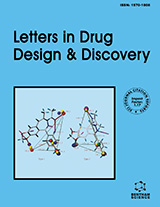Abstract
Background: For the past several decades, the presence of tuberculosis (TB) is being remarked as the most common infectious disease leading to mortality.
Objective: Hydrazone containing azometine group (-NHN=CH-) compounds have been reported for a broad range of bioactivities such as antiplatelet, analgesic, anti-inflammatory, anticonvulsant, antidepressant, antimalarial, vasodilator, antiviral, and antimicrobial, etc.
Methods: For the synthesis of compounds (4a-4d) and (6a-6e), aromatic amines were treated with methyl terephthalaldehydate in methanol, giving Schiff’s bases, followed by reductive amination and further treatment with hydrazine hydrate gave acid hydrazides (4a-4d). These acid hydrazides were then treated with different aromatic aldehydes to yield hydrazones (6a-6d). All the synthesized compounds were subjected to FT-IR, NMR, and UV spectroscopic characterization.
Results: Compounds (4a-4d) and (6a-6e) were found to have highly potent activity against Mycobacteria tuberculosis (Vaccine strain, H37 RV strains): ATCC No- 27294 (MIC:1.6-6.25 μg/mL) than standard anti-TB drugs. The compounds exhibited good radical scavenging potentials(0- 69.2%), as checked from DPPH protocol. All compounds also demonstrated good in-silico ADMET results.
Conclusion: The current study revealed promising in vitro anti-tuberculosis and anti-oxidant profiles of hydrazide-hydrazone analogues.
Keywords: Hydrazide-hydrazones, anti-oxidant activity, anti-tuberculosis activity, in silico analysis, tuberculosis, synthesis.
Graphical Abstract
Current Computer-Aided Drug Design
Title:Synthesis, admetSAR Predictions, DPPH Radical Scavenging Activity, and Potent Anti-mycobacterial Studies of Hydrazones of Substituted 4-(anilino methyl) benzohydrazides (Part 2)
Volume: 17 Issue: 4
Author(s): Vijay J. Desale, Suraj N. Mali, Bapu R. Thorat*Ramesh S. Yamgar
Affiliation:
- Department of Chemistry, Government of Maharashtra’s Ismail Yusuf College, Jogeshwari, Mumbai-400060,India
Keywords: Hydrazide-hydrazones, anti-oxidant activity, anti-tuberculosis activity, in silico analysis, tuberculosis, synthesis.
Abstract:
Background: For the past several decades, the presence of tuberculosis (TB) is being remarked as the most common infectious disease leading to mortality.
Objective: Hydrazone containing azometine group (-NHN=CH-) compounds have been reported for a broad range of bioactivities such as antiplatelet, analgesic, anti-inflammatory, anticonvulsant, antidepressant, antimalarial, vasodilator, antiviral, and antimicrobial, etc.
Methods: For the synthesis of compounds (4a-4d) and (6a-6e), aromatic amines were treated with methyl terephthalaldehydate in methanol, giving Schiff’s bases, followed by reductive amination and further treatment with hydrazine hydrate gave acid hydrazides (4a-4d). These acid hydrazides were then treated with different aromatic aldehydes to yield hydrazones (6a-6d). All the synthesized compounds were subjected to FT-IR, NMR, and UV spectroscopic characterization.
Results: Compounds (4a-4d) and (6a-6e) were found to have highly potent activity against Mycobacteria tuberculosis (Vaccine strain, H37 RV strains): ATCC No- 27294 (MIC:1.6-6.25 μg/mL) than standard anti-TB drugs. The compounds exhibited good radical scavenging potentials(0- 69.2%), as checked from DPPH protocol. All compounds also demonstrated good in-silico ADMET results.
Conclusion: The current study revealed promising in vitro anti-tuberculosis and anti-oxidant profiles of hydrazide-hydrazone analogues.
Export Options
About this article
Cite this article as:
Desale J. Vijay , Mali N. Suraj , Thorat R. Bapu *, Yamgar S. Ramesh , Synthesis, admetSAR Predictions, DPPH Radical Scavenging Activity, and Potent Anti-mycobacterial Studies of Hydrazones of Substituted 4-(anilino methyl) benzohydrazides (Part 2), Current Computer-Aided Drug Design 2021; 17 (4) . https://dx.doi.org/10.2174/1573409916666200615141047
| DOI https://dx.doi.org/10.2174/1573409916666200615141047 |
Print ISSN 1573-4099 |
| Publisher Name Bentham Science Publisher |
Online ISSN 1875-6697 |
 23
23
- Author Guidelines
- Bentham Author Support Services (BASS)
- Graphical Abstracts
- Fabricating and Stating False Information
- Research Misconduct
- Post Publication Discussions and Corrections
- Publishing Ethics and Rectitude
- Increase Visibility of Your Article
- Archiving Policies
- Peer Review Workflow
- Order Your Article Before Print
- Promote Your Article
- Manuscript Transfer Facility
- Editorial Policies
- Allegations from Whistleblowers
Related Articles
-
Increased [11C]Choline Uptake in Bronchioloalveolar Cell Carcinoma with Negative [18F]FDG Uptake. A PET/CT and Pathology Study
Current Radiopharmaceuticals Editorial (Thematic Issue: Perspective of Bacterial Vaccines -Part II)
Current Pharmaceutical Biotechnology Innate Immunity and Primary Biliary Cirrhosis
Current Molecular Medicine Biology of gama delta T Cells in Tuberculosis and Malaria
Current Molecular Medicine Label-Free Cell Phenotypic Drug Discovery
Combinatorial Chemistry & High Throughput Screening Advancement in Vaccinology: New Era in Formulation Strategies
Current Drug Therapy The Spectrum of Cefditoren for Lower Respiratory Tract Infections (LRTIs) in Surabaya
Current Drug Therapy S-Nitrosylation: Targets, Controls and Outcomes
Current Genomics Is Targeting microRNAs the Philosopher’s Stone for Vascular Disease?
Current Vascular Pharmacology Editorial (Thematic Issue: Challenging Organic Syntheses and Pharmacological Applications of Natural Products and their Derivatives – Part II)
Current Pharmaceutical Design Formulation and Evaluation of Isoniazid Loaded Nanosponges for Topical Delivery
Pharmaceutical Nanotechnology Chemical and Bioactive Diversities of the Genus Chaetomium Secondary Metabolites
Mini-Reviews in Medicinal Chemistry Response to HAART in Treatment-Naive HIV-Infected Patients with a Prior Diagnosis of Tuberculosis or other Opportunistic Infections
Current HIV Research Anti-Tuberculosis
Current Bioactive Compounds Role of Cytokines in Chlamydia trachomatis Protective Immunity and Immunopathology
Current Pharmaceutical Design Targeting Monoamine Oxidases with Multipotent Ligands: An Emerging Strategy in the Search of New Drugs Against Neurodegenerative Diseases
Current Medicinal Chemistry The Chemical Composition and Anti-mycobacterial Activities of <i>Trachyspermum copticum</i> and <i>Pelargonium graveolens</i> Essential Oils
Recent Patents on Anti-Infective Drug Discovery Epidemiology of Candida albicans Infections and Role of Non-Candidaalbicans Yeasts
Current Drug Targets Topical Antimicrobials for Burn Wound Infections
Recent Patents on Anti-Infective Drug Discovery Hepatitis C Viruss Immune Evasion Strategies
Current Immunology Reviews (Discontinued)



























